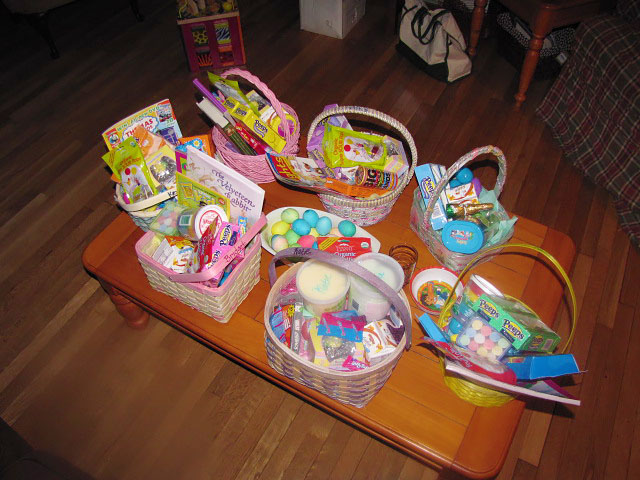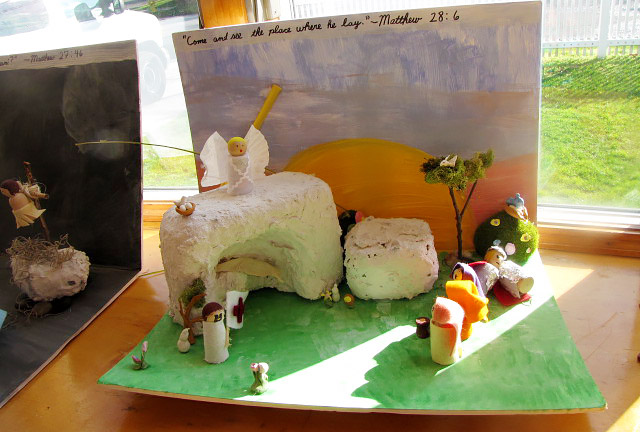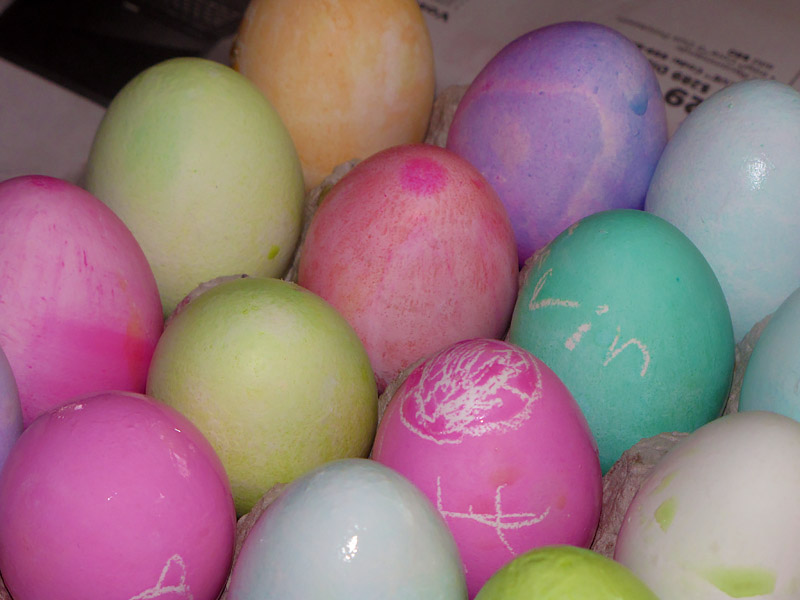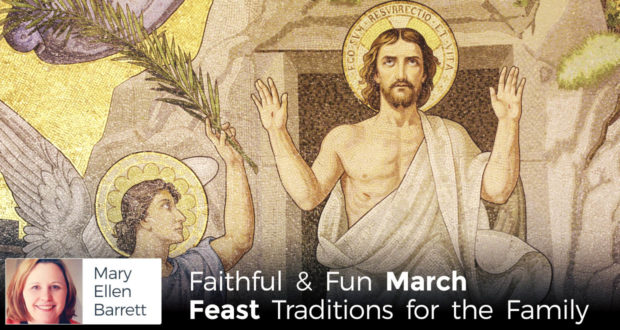March can be a challenging month when it comes to feasting, because usually all or part of it is in Lent, and Lent can be challenging for young children.
There are fewer sweets in the house, and we pray more frequently and with greater fervor. Maybe Mom and Dad have given up such things as coffee or their glass of wine with dinner, so perhaps they’re also a little, um…. crankier than normal.
Or maybe that’s just me.
Yes, Lent is challenging, but it should be. We should embrace the challenges, showing the children that our little sacrifices can be done with good grace and serenity.
Matthew 6:16-18 “And when you fast, do not look gloomy like the hypocrites, for they disfigure their faces that their fasting may be seen by others. Truly, I say to you, they have received their reward. But when you fast, anoint your head and wash your face, that your fasting may not be seen by others but by your Father who is in secret. And your Father who sees in secret will reward you.”
So as Lent continues, there are challenges but still many opportunities for tradition and observance. And, of course, this month there is the greatest feast of all, Easter.
So the list, short this month, is:
March 5 – St. Ciaran
March 8 – St. John of God
March 13 – Passion Sunday
March 17 – St. Patrick
March 19 – St. Joseph
March 20 – Palm Sunday
March 24 – Maundy Thursday
March 25 – Passion Friday
March 26 – Holy Saturday
March 27 – Easter
March gives us the opportunity to explore two great heritages, Irish and Italian, as well as to rejoice in the Resurrection. Here are some ways to make these feasts part of your month.
St. Ciaran
St. Ciaran is called the first saint of Ireland. He was one of what are known as the Twelve Apostles of Ireland, “Dhá Aspal Déag na hÉireann” in Irish. Those are the monastic saints who studied under Saint Finnian at Clonnard Abbey in the early sixth century.
St. Ciaran was born in Ireland and is said to have longed for God in his heart before he even had heard one word about God. He worshiped in his heart among the animals in the woods near his home.
He eventually made his way to Rome and was baptized at the first church to which he came. Years later, he was asked to return to Ireland by Saint Patrick himself and did so, eventually building himself a hermitage at Saigir.
We always read the beautiful book Saint Ciaran, The Tale of a Saint of Ireland by Gary D. Schmidt on this feast day. It’s a beautifully written and illustrated picture book combining fact and legend about this holy man.
The book lends itself well to copywork as well as trying to imitate the illustrations with watercolors. There is much nature study to be had as well, since Ciaran was known to be loved by the animals and they feature largely in the tale.
On Saint Ciaran’s day, I like to make animal-shaped cookies and serve them with tea while I read the story to the children. The website Monastic Ireland is great fun to explore, as it tells the stories of the Twelve Irish Apostles.
St. Patrick
You might think I am favoring the Irish saints. You’re right. I’m very proud of my Irish heritage and I enjoy sharing it with my children. I’m hoping my traditions will become theirs when they raise their own families.
Now I know that Patrick wasn’t Irish; he was Roman, but the Irish have claimed him, and he’s a wonderful example of perseverance, holiness and wit. There are many excellent books for children about St. Patrick, but our favorite is Patrick, Patron Saint of Ireland by Tomie DePaola. The illustrations are simple, but lovely, and easily copied for your young artist to practice.
Cutting out paper shamrocks and labeling the leaves Father, Son and Holy Spirit–as St. Patrick used the plant to explain the Trinity–is a nice way to make the concept come to life for young children. Use the completed ones to decorate your windows. Baking shamrock sugar cookies is also fun.
Making a Saint Patrick spoon saint (directions on Cottage Blessings blog) is a cute, quick little craft.
There is also a DVD from CCC called Patrick, Brave Shepherd of Ireland. It’s an animated story but beloved at our house by all ages.
We also love to listen to Celtic Women (the 2005 CD has a beautiful version of the Ave Maria) and the Irish Tenors.
The food choices are abundant. We are in luck that this year the feast does not fall on Friday, so meat can be eaten. The American tradition is to eat corned beef and cabbage on this day, but why not try something more traditional?
Bangers and mash, which is Irish sausage served with mashed potatoes and onion gravy; a side of peas or baked beans; colcannon; lamb stew; shepherd’s pie; or Dublin coddle are all traditional and worth trying.
Whatever you serve, it should be accompanied by a slab of either brown bread or, my favorite, Irish soda bread. I use my grandmother’s recipe which she brought over from Tuam (pronounced choom) in county Galway. You’ll find it below, with my compliments for a Happy Saint Patrick’s day. Sona lá st Pádraig!
St. Joseph
St. Joseph’s day is dear to the heart of our Italian friends because it was through his intercession that God saved the Sicilian people from a drought during the Middle Ages. It is traditional for Italians to wear red on this day to honor their beloved saint, much the same way the Irish wear green to honor Patrick.
Joseph is the patron of families, workers, immigrants and the Universal Church, so he is a good guy to have praying for you. The St. Joseph “Memorare” is worn out in my little prayer book, and he never fails me.
“Remember, O most pure spouse of the Blessed Virgin Mary, my sweet protector St. Joseph, that no one has ever had recourse to your protection, or implored your aid without obtaining relief. Confiding, therefore, in your goodness, I come before you, and fervently recommend myself to you. O despise not my petitions, foster-father of the Redeemer but graciously receive them! Amen.”
I love to read Good Saint Joseph by Father Lovasik on this day with my young ones.
Make St. Joseph’s staffs as a snack by rolling crescent dough into staffs or crooks and sprinkling with cinnamon sugar before baking.
St. Joseph altars are a popular tradition: a table with a statue of St. Joseph and some candles and then laden with Italian foods, especially breads baked into interesting shapes, cookies, cakes, bottles of wine and other delectables.
While this tradition started in Sicily, it has now become a tradition for anyone who loves great Saint Joseph. Some are very humble and others quite elaborate, but it is a lovely tradition however you choose to do it.
Palm Sunday
All children love to receive palms in church. However, palms can quickly become a big distraction on a day when Mass might be particularly long. I have found it helpful to put in a little time the day before (at dinner usually) to prepare the children for what is to occur. Even the ones who are a little older can always do with a refresher in what to expect, so the time is well worth it.
Make sure to point out that the priests will be in red vestments on this day and Mass will begin at the door of the church as the priest blesses the palms. The entrance on this day is meant to imitate the entrance of Christ into Jerusalem and introduces us to the solemnity of the week to come.
A reminder is appropriate at this point that the palms are a blessed sacramental and not to be used as a weapon or adornment (no necklace making). Here is a video on how to weave a simple palm cross. I like to do this and then hang one in each child’s room.
Holy Monday
Not a feast or an observance but a good day to prepare for the Masses and services coming at the end of the week. Here is a survival guide to help you out.
Maundy Thursday
Maundy comes from Mandatum novum do vobis, which means “a new commandment I give to you.” In my opinion, this is the most liturgically rich day in the Church calendar. Maundy Thursday Mass and its accompanying traditions and rituals are so very beautiful to share with your children.
Before Mass, reading the story of the last supper and explaining the significance of all that occurs is extremely helpful. If attending the Mass of the Last Supper (which is late and long) seems like too much for your family, the Chrism Mass that takes place in the morning is a beautiful celebration.
The renewal of baptismal vows and the unity expressed between the Bishop and his priests as they renew their vows of obedience makes this a Mass that shines with particular beauty and majesty.
Good Friday
Hot cross buns. Need I say more? Of course I must, but whether you have a favorite recipe or go store-bought, start the long fast day with this simple traditional breakfast. We always attend services on Good Friday, but it’s not a holy day of obligation so if it is too much for your young family, don’t feel bad for not attending. If you do go, make sure that little ones are fed and rested so as to not be too restless during the service.
In the evening, after a simple supper, the older children watch The Passion of the Christ with us. It’s a good movie for Good Friday, but at what age it’s appropriate to see should be carefully discerned by parents. It’s not for the faint of heart or for an easily disturbed young person.
Holy Saturday
In our family, this is the traditional egg dyeing day. We prepare for the coming feast and attend the Vigil. I try to build up some excitement about the next day. We put up our Resurrection display, waiting until the next day to add the Risen Christ.
Easter Sunday
Time to celebrate! When the children awake, the Alleluia banner we “buried” in a special box is hanging on the mantel and our crown of thorns is covered in flowers. Oh, and there are baskets. I generally fill the baskets with saint books, holy cards, art supplies, and candy. I try to make sure there is a religious component to them as well as being festive and fun.



I hope these ideas help you establish some liturgical traditions for March in your home. I wish all of you reading this a blessed Easter!
Grandma Conlon’s Soda Bread
4 cups flour
2/3 cup sugar
1 tsp salt
2 tsp baking powder
2 tsp baking soda
1 tbsp caraway seeds
1 stick butter, sliced
1 cup raisins
1 1/3 cup buttermilk
2 eggs
Sift together flour, sugar, salt, baking powder & baking soda. Stir in caraway. Cut butter in using a fork. Squeeze flour together with hands. Add raisins. Beat buttermilk and eggs and add to flour mixture. Knead by hand about 25 times. Shape into a round loaf and bake at 350 degrees for one hour.
Christ header image CC Fr Lawrence Lew | FLickr

 Seton Magazine Catholic Homeschool Articles, Advice & Resources
Seton Magazine Catholic Homeschool Articles, Advice & Resources
